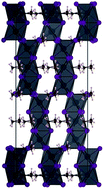当前位置:
X-MOL 学术
›
J. Mater. Chem. A
›
论文详情
Our official English website, www.x-mol.net, welcomes your feedback! (Note: you will need to create a separate account there.)
Azetidinium lead iodide for perovskite solar cells
Journal of Materials Chemistry A ( IF 11.9 ) Pub Date : 2017-09-20 00:00:00 , DOI: 10.1039/c7ta07545f S. R. Pering 1, 2, 3, 4 , W. Deng 1, 2, 3, 4 , J. R. Troughton 4, 5, 6, 7 , P. S. Kubiak 1, 2, 3, 4, 8 , D. Ghosh 2, 3, 4, 9 , R. G. Niemann 1, 2, 3, 4 , F. Brivio 1, 2, 3, 4 , F. E. Jeffrey 2, 3, 4, 10 , A. B. Walker 2, 3, 4, 9 , M. S. Islam 1, 2, 3, 4, 10 , T. M. Watson 4, 5, 6, 7 , P. R. Raithby 1, 2, 3, 4 , A. L. Johnson 1, 2, 3, 4, 10 , S. E. Lewis 1, 2, 3, 4, 10 , P. J. Cameron 1, 2, 3, 4, 10
Journal of Materials Chemistry A ( IF 11.9 ) Pub Date : 2017-09-20 00:00:00 , DOI: 10.1039/c7ta07545f S. R. Pering 1, 2, 3, 4 , W. Deng 1, 2, 3, 4 , J. R. Troughton 4, 5, 6, 7 , P. S. Kubiak 1, 2, 3, 4, 8 , D. Ghosh 2, 3, 4, 9 , R. G. Niemann 1, 2, 3, 4 , F. Brivio 1, 2, 3, 4 , F. E. Jeffrey 2, 3, 4, 10 , A. B. Walker 2, 3, 4, 9 , M. S. Islam 1, 2, 3, 4, 10 , T. M. Watson 4, 5, 6, 7 , P. R. Raithby 1, 2, 3, 4 , A. L. Johnson 1, 2, 3, 4, 10 , S. E. Lewis 1, 2, 3, 4, 10 , P. J. Cameron 1, 2, 3, 4, 10
Affiliation

|
Hybrid organic–inorganic perovskites have been established as good candidate materials for emerging photovoltaics, with device efficiencies of over 22% being reported. There are currently only two organic cations, methylammonium and formamidinium, which produce 3D perovskites with band gaps suitable for photovoltaic devices. Numerous computational studies have identified azetidinium as a potential third cation for synthesizing organic–inorganic perovskites, but to date no experimental reports of azetidinium containing perovskites have been published. Here we prepare azetidinium lead iodide for the first time. Azetidinium lead iodide is a stable, bright orange material which does not appear to form a 3D or a 2D perovskite. It was successfully used as the absorber layer in solar cells. We also show that it is possible to make mixed cation devices by adding the azetidinium cation to methylammonium lead iodide. Computational studies show that the substitution of up to 5% azetidinium into the methylammonium lead iodide is energetically favourable and that phase separation does not occur at these concentrations. Mixed azetidinium–methylammonium cells show improved performance and reduced hysteresis compared to methylammonium lead iodide cells.
中文翻译:

钙钛矿太阳能电池用叠氮碘化铅碘化物
混合有机-无机钙钛矿已被确定为新兴光伏的良好候选材料,据报道器件效率超过22%。当前只有两种有机阳离子,甲基铵和甲ami,它们可产生带隙适合于光伏设备的3D钙钛矿。大量的计算研究已将氮杂环丁烷视为合成有机-无机钙钛矿的潜在第三阳离子,但迄今为止,尚未发表有关含氮杂环丁鎓钙钛矿的实验报告。在这里,我们首次制备了氮杂环丁烷碘化铅。氮丙啶鎓碘化铅是一种稳定的亮橙色材料,似乎不会形成3D或2D钙钛矿。它已成功用作太阳能电池的吸收层。我们还表明,可以通过将氮杂环丁烷阳离子添加到甲基铵碘化铅中来制造混合阳离子设备。计算研究表明,将高达5%的氮杂环丁烷取代成甲基铵碘化铅在能量上是有利的,并且在这些浓度下不会发生相分离。与甲基铵碘化铅电池相比,混合的氮杂环丁烷-甲基铵电池显示出更高的性能,并减少了磁滞现象。
更新日期:2017-09-22
中文翻译:

钙钛矿太阳能电池用叠氮碘化铅碘化物
混合有机-无机钙钛矿已被确定为新兴光伏的良好候选材料,据报道器件效率超过22%。当前只有两种有机阳离子,甲基铵和甲ami,它们可产生带隙适合于光伏设备的3D钙钛矿。大量的计算研究已将氮杂环丁烷视为合成有机-无机钙钛矿的潜在第三阳离子,但迄今为止,尚未发表有关含氮杂环丁鎓钙钛矿的实验报告。在这里,我们首次制备了氮杂环丁烷碘化铅。氮丙啶鎓碘化铅是一种稳定的亮橙色材料,似乎不会形成3D或2D钙钛矿。它已成功用作太阳能电池的吸收层。我们还表明,可以通过将氮杂环丁烷阳离子添加到甲基铵碘化铅中来制造混合阳离子设备。计算研究表明,将高达5%的氮杂环丁烷取代成甲基铵碘化铅在能量上是有利的,并且在这些浓度下不会发生相分离。与甲基铵碘化铅电池相比,混合的氮杂环丁烷-甲基铵电池显示出更高的性能,并减少了磁滞现象。



























 京公网安备 11010802027423号
京公网安备 11010802027423号